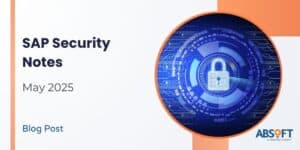Robotic Process Automation (RPA) is an IT functionality that automates many tedious and monotonous tasks. SAP Intelligent RPA (IRPA) is unique as it incorporates AI to provide a no-code, end-to-end solution.
Installing and understanding all the features SAP IRPA presents can seem daunting. With this in mind, our experts have gathered all the information you may need about this innovative solution in this blog post. We trust that this article will be of benefit to you.
Don’t hesitate to get in touch if you require any help or have a question.Â
Table of Contents
What is SAP IRPA and what makes it unique?
To achieve their automation processes, RPA systems utilise Bots, which SAP consultants or expert users design and create. They can be set up in either an ‘attended’ mode – requiring supervision by a user – or an ‘unattended’ mode – performing specific tasks in the background – which a supervisor console orchestrates and monitors. Where SAP IRPA differs is its integration of AI as a no-code, end-to-end solution that includes on-premise tools.
Similar tools like Macros and VBA Scripts can automate tasks in the Microsoft Suite but are limited to single applications and cannot cross non-Microsoft applications. This is where SAP IRPA comes in as it can work with non-SAP and legacy systems plus other SAP solutions such as Digital Core, Ariba, Concur, etc. In addition, IRPA does not need any programming skills to build a Bot.
SAP IRPA has three components: the Desktop Agent, Cloud Factory, and Desktop Studio. Let’s look at them in detail!
Desktop Agent
This component overlays UI elements on top of business applications to perform operations like clicking, navigating, and data manipulation on the user screen without modifying their code. This is useful for collecting and presenting data to the user for final “Go/No Go” decisions. It has various features to interact with applications such as SAP, webpages, custom applications, etc. The Agent can connect to APIs, file systems and database APIs, accomplish tasks, and get results. Connecting to SAP Intelligent services like conversational AI and Leonardo Machine Learning is also possible.
Based on JavaScript, a cloud administrator installs the Desktop Agent on an end user’s computer. The Agent then adopts the user profile and Windows credentials for its operations, no longer requiring administrator privileges. Cloud Factory registration establishes Agent security, with a secure WebSocket connecting the Agent to the Factory – the latter handling authentication.

Cloud Factory
This is the Bot Management Central component and orchestrates all process automation. It manages processes in the landscape and presents them as a dashboard featuring four sub-components: Hierarchies, Environments, Packages, and Configurations. As a GDPR-compliant solution, data privacy and protection are in-built so the administrator can delete user-provided data if needed. The system supports five different languages – English, German, French, Spanish, and Japanese.

In Hierarchy, a structured set of machines and agents that are responsible for running the Bots are defined. Here the user schedules when Bots run in attended or unattended modes for operation at night-time and non-peak hours. These schedules depend on the workload distribution in an organisation and can be assigned per node or per agent.
Environment captures information such as URLs, credentials, variables, etc and groups them to specific runtimes. One of the SAP-recommended DEV, TEST, or PROD types binds with this sub-component; the DEV environment develops Bots, TEST accesses them, and PROD deploys them. The users may create any number of environments as needed. The Environment binds to a Hierarchy, enabling the Hierarchy to derive runtime information from the linked environment.
The Cloud Factory Monitoring Dashboard provides a snapshot of all the essential information on the Bots, such as the current status of Bots, histories of different Bot executions, and a library of job outcomes.
Desktop Studio
This tool develops the Bots and combines all the relevant information to deliver the Package. Once developed, the package must be imported into Cloud Factory, where it is given a Configuration. This would typically consist of parameters such as which attendance mode it runs in, the Package’s schedule, when Bots activate, etc. All Packages bind to an Environment.
Desktop Studio is an integrated development environment and features three sub-components: the Application Capture tool, Workflow designer, and Code Editor & built-in debugger.
Application Capture Tool
This tool, designed to capture user screen elements, allows users to capture and identify the elements requiring data input or actions. Users save these elements using the tools option, move to the next screen for data capture, and repeat the process, generating unique identifiers for each element. Users can manually adjust identifiers with the tool’s validation wizard to facilitate understanding and documentation. This validation is crucial to guarantee that actions are executed accurately on the correct UI elements for desired results.

Workflow Designer
Once the application and its UI elements have been captured to tailor into a process, the Workflow Designer comes in. A process flow is built by clicking a start workflow icon and then dragging and dropping the different screens, along with any captured elements. Upon completing the process and saving, the JavaScript code is generated at the click of a button.

Code Editor and Built-in Debugger
Enabling developers to add and tweak their own piece of code once it’s generated in the Workflow designer, the tool gives them access to the SAP-provided software development kit and allows them to build and include their own JavaScript libraries.
It is possible to navigate between the workflow and the code anytime. This tool helps to design and generate UIs that can interact with users. For example, it can be used to bring a pop-up of help info in a user application screen. It provides features such as a step-by-step execution, variable watch, breakpoints, etc. and contains a complete debugger and a UI designer tool.

SAP IRPA Use Cases
SAP IRPA includes all the necessary features for Bot creation, orchestration, testing, packaging, and monitoring. With these capabilities, these tools have a variety of use cases and advantages over other similar systems, including:
- Simplifying automation with drag-and-drop elements and AI integration
- Develop faster using pre-built workflows, Bots, and connectors for SAP and non-SAP systems
- Enabling fusion team development in a secure and agile fashion
- Automatic creation of Sales orders from Excel
- Enabling mass creation of Purchase Requisitions from Excel
- Automating tedious, time-consuming, and error-prone tasks such as consolidation and manipulation of data from multiple data sources
- Automating repetitive high-volume tasks that must be completed time after time, such as during data migrations
- Automating tasks that involve accessing multiple applications that offer no suitable APIs, including Web applications, legacy business solutions, and software-as-a-service (SaaS) offerings
- Extracting data from large numbers of digital documents or scanned images and transferring it to your enterprise systems for processing
- Extracting data from structured data sources such as Excel files and unstructured data sources such as PDF, PNG, JPEG, etc
- Enriching extracted data based on your own master data and connect your incoming document-based extractions to a unique ID that your system understands to process further

Next Steps with SAP IRPA
SAP has articulated a great roadmap ahead for IRPA, which creates a layer that sits on top of existing systems and processes without needing to rewrite thousands of lines of code. The automation covers end-to-end steps of the process, spanning across many systems, including non-SAP solutions. These features create significant advantages for every organisation, allowing them to minimise time reviewing existing processes and developing areas of optimisation using RPA. It presents an excellent opportunity for SAP consultants to review and implement RPA across various areas, delivering immense value to customers.
To set up SAP IRPA in your business, contact one of Absoft’s experts today.















